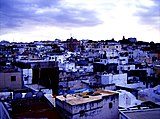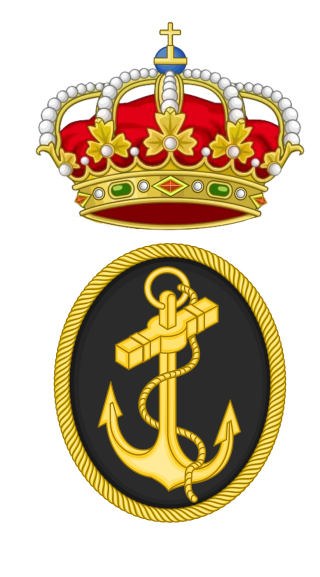
The Spanish Navy, officially the Armada, is the maritime branch of the Spanish Armed Forces and one of the oldest active naval forces in the world. The Spanish Navy was responsible for a number of major historic achievements in navigation, the most famous being the discovery of America and the first global circumnavigation. For several centuries, it played a crucial logistical role in the expansion and consolidation of the Spanish Empire, and defended a vast trade network across the Atlantic Ocean between the Americas and Europe, and the Manila Galleon across the Pacific Ocean between the Philippines and the Americas.

The Battle of Cape Palos, also known as the Second Battle of Cape Palos, was the biggest naval battle of the Spanish Civil War, fought on the night of March 5–6, 1938, east of Cape Palos near Cartagena, Spain.
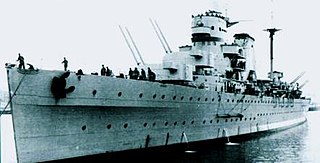
The Canarias class was a class of heavy cruiser of the Spanish Navy. Two ships of the class were completed in the 1930s. They were built in Spain by the Vickers-Armstrongs subsidiary Sociedad Española de Construcción Naval upon a British design, and were a modified version of the Royal Navy′s County class. The two ships completed, Canarias and Baleares, both saw service during the Spanish Civil War, the latter being sunk.
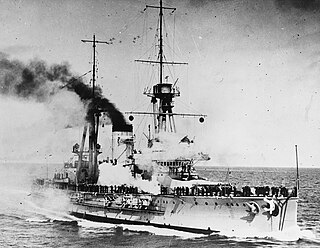
Alfonso XIII was the second of three España-class dreadnought battleships built in the 1910s for the Spanish Navy. Named after King Alfonso XIII of Spain, the ship was not completed until 1915 owing to a shortage of materials that resulted from the start of World War I the previous year. The España class was ordered as part of a naval construction program to rebuild the fleet after the losses of the Spanish–American War; the program began in the context of closer Spanish relations with Britain and France. The ships were armed with a main battery of eight 305 mm (12 in) guns and were intended to support the French Navy in the event of a major European war.

The Churruca class was a Spanish destroyer class built for the Spanish Navy based on a British design. Eighteen ships were built, with two being sold to Argentina and commonly referred to as the Cervantes class. The last two members of the class are sometimes referred to as a separate class, the Alava class.

Sánchez Barcáiztegui was a Churruca-class destroyer of the Spanish Republican Navy. She took part in the Spanish Civil War on the side of the government of the Second Spanish Republic.

Almirante Ferrándiz was a Churruca-class destroyer in the Spanish Republican Navy. She took part in the Spanish Civil War on the government side.

Lepanto was a Churruca-class destroyer of the Spanish Republican Navy. She took part in the Spanish Civil War on the side of the government of the Second Spanish Republic. She was named after the Battle of Lepanto.

The Almirante Cervera class were three light cruisers built for the Spanish Navy in the 1920s. The ships were built by Sociedad Española de Construcción Naval in Ferrol which had strong British links and were designed by Sir Philip Watts. It has often been stated that the design was based on the British Emerald-class cruiser, but this seems not in fact to have been the case, although they were clearly an inspiration for the concept of the Spanish ships. The main armament comprised Vickers pattern 6-inch guns with single mountings in "A" and "Y" positions and twin turrets in "B", "Q" and "X" positions. The programme was initially authorised in 1915 but was delayed by World War I with construction of the first ship starting in 1917.
Navarra was a cruiser serving the Spanish Navy from 1923 to 1956. Construction on Reina Victoria Eugenia—the ship's original name—began in 1915 by Sociedad Española de Construcción Naval in Ferrol. The design showed considerable British design influence resembling contemporary British Town-class cruisers. The boilers were re-arranged into three rooms to give three funnels. The ship was renamed República in 1931 and assumed the name Navarra in 1936.

Júpiter-class minelayers was a group of four vessels of the Spanish Republican Navy built during the Spanish Republic. Three of them came into service during the Civil War after joining the rebel side.

Almirante Cervera was a light cruiser and lead ship of the Almirante Cervera class of the Spanish Navy. She was named after the Spanish admiral Pascual Cervera y Topete, commander of the Spanish naval forces in Cuba during the Spanish–American War. She was part of the Spanish Republican Navy between 1931 and 1936, year in which she became a key player of the Nationalist Fleet in the Spanish Civil War.
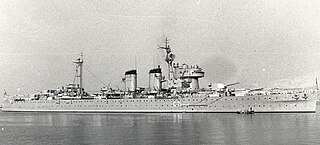
Canarias was a Canarias-class heavy cruiser of the Spanish Navy. She was built in Spain by the Vickers-Armstrongs subsidiary Sociedad Española de Construcción Naval based on a British design, being a modified version of the Royal Navy′s County class. Canarias saw service during the Spanish Civil War.

Baleares was a Canarias-class heavy cruiser of the Spanish Navy whose control was taken by the Nationalist side during the Spanish Civil War. The two ships of the class were built upon a British design and were a modified version of the Royal Navy′s County class. Baleares was constructed in Spain by the Vickers-Armstrongs subsidiary Sociedad Española de Construcción Naval, and saw service during the Spanish Civil War, when she was torpedoed and sunk by destroyers of the Spanish Republican Navy during the Battle of Cape Palos.

The Spanish Republican Navy was the naval arm of the Armed Forces of the Second Spanish Republic, the legally established government of Spain between 1931 and 1939.

Luis González de Ubieta y González del Campillo was an admiral of the Spanish Republican Navy during the Spanish Civil War. He died in exile as the captain of the Panamanian merchant vessel Chiriqui, refusing to be rescued when the ship under his command sank in the Caribbean Sea not far from Barranquilla.
Almirante Miranda (AM) was a Churruca-class destroyer that fought in the Spanish Civil War on the Republican side and, after the war, joined the post-war Spanish Navy. She was named after Admiral Augusto Miranda y Godoy, a Spanish Minister of the Navy.
Almirante Antequera (AA) was a 2nd series Churruca-class destroyer that fought on the Republican side during the Spanish Civil War and, after the war, joined the post-war Spanish Navy. She was named after Juan Bautista Antequera y Bobadilla, a vice admiral and Spanish Minister of the Navy.

Miguel de Cervantes was an Almirante Cervera-class light cruiser that served in the Spanish Navy. She fought in the Spanish Civil War on the Republican side, before joining the post-war Spanish Navy. She was ordered by a Royal Decree on 31 March 1926, as part of a naval construction project headed by Counter Admiral Honorio Cornejo.














